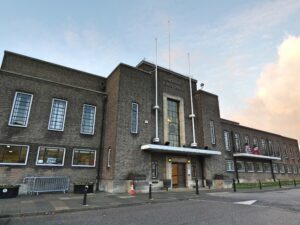
Havering Town Hall
(Written by Local Democracy Reporter, Sebastian Mann)
The London borough falls short of the international recommendations laid out by the World Health Organisation (WHO) to ensure people are breathing healthy air.
Data shows the amount of airborne pollutants in the borough is more than double the WHO’s minimum, meaning residents face a higher risk of illness.
According to the WHO, air pollution is the “greatest environmental threat” to health and can cause cancer, respiratory diseases, and strokes.
A spokesperson for Havering Council told the Local Democracy Reporting Service (LDRS): “Air pollution and the health impacts is rightly a concern for many parents and young people.
“While we meet UK limits, we recognise we don’t meet WHO recommendations along with the rest of London and we know there is more work to be done.”
Air quality is measured by the amount of microscopic pollutants floating around. Readings, taken every hour in the UK, record the number of micrograms (?g) – one-millionth of a gram – per cubic metre of air (m3).
The rate of nitrogen dioxide (NO2) particles in Havering is around 25?g/m3, more than twice the WHO’s target of 10?g/m3, according to London Air.
NO2 is a byproduct of diesel and fuel cars, and is considered “damaging to human health” by the government.
The authority published a three-year climate action plan earlier this year, having declared a ‘climate emergency’ last March.
The 23-page scheme lays out Havering’s plans to “accelerate” the adoption of electric vehicles in the borough and “cut ‘dirty’ fuel vehicle trips” while promoting “sustainable” alternatives, such as walking and cycling.
The spokesperson added: “We must all play a part in helping to improve our air quality, from leaving the car at home and walking for shorter journeys, using other forms of active travel or public transport where possible, and not using wood burners. We can all make a difference.”
Though Havering falls behind the WHO’s targets, it is safely below the UK legal limit of 40?g/m3.
Jemima Hartshorn, from campaign group Mums for Lungs, said: “Thousands of children [across London] are unable to breathe because of preventable air pollution – this must change.
“So many children are being admitted to hospitals with serious cases of asthma, and all the evidence shows that damaging lungs at an early age can cause lifelong health conditions.
“The next national government, mayors and local authorities must all use their powers to phase out diesel vehicles and protect children from painful and debilitating health conditions.”
A Freedom of Information request, published by the campaigners, found that 2,142 children up to five years old had been admitted to Queen’s Hospital with breathing problems in 2023.
That was the highest rate across both inner and outer London. There had also been 2,122 admissions to West Middlesex Hospital, in Hounslow, and 1,071 to King George Hospital, in neighbouring Redbridge.
The Barking, Havering, Redbridge University NHS Trust (BHRUT), which oversees the Romford hospital, was contacted for comment.
Mums for Lungs has also called for diesel cars to be taken off the roads by 2030, five years ahead of the current national target.
The Havering spokesperson added it was “beyond the council’s powers” to determine private vehicle policies and it would be for the government to “set the timelines for phasing out specific types”.
Transport for London (TfL) says it has committed £11.8million to Havering for residents to “transition to cleaner, greener methods of transport” as part of the ultra-low emission zone (ULEZ) policy.
The controversial scheme was expanded London-wide in August last year and now covers most of Havering. Introduced by London mayor Sadiq Khan in 2019, it encourages motorists to drive low-emission electric cars in the capital or face a £12.50 daily charge.
Christina Calderato, TfL’s director of transport strategy and policy, told the LDRS: “London’s comprehensive public transport system gives people a significant incentive to swap the car for a more environmentally friendly option.
“This includes links to central London from Hornchurch and Upminster, via the District and Elizabeth lines and an extensive local bus network.”
TfL has also proposed improving bus links in Upminster and Harold Hill.
Analysis from the department suggests that roadside concentrations of NO2 are around 46% lower in central London than they would be without the ULEZ restrictions in place.